Some aquarium success articles you see are full of prideful brags. I’m guilty of that myself, from time to time. But when it came to breeding the Banggai cardinalfish, you will see that I got lucky and made lots of mistakes, If you’re interested in following in my footsteps, though, these forgiving fish will reward you in the end. If you have been thinking about breeding saltwater fish but delaying for one reason or another, do it. And leave me a comment to let me know how it’s going!
Table of Contents: Breeding the Banggai Cardinalfish
A while back, I wrote an article about breeding the Banggai cardinalfish, published in Aquarium Fish International. To meet their formatting and standards, I needed to omit my intended (bad) humor. I still wanted to share my success with breeding this awesome saltwater fish. Why? Because this fish needs our help. Wild collection is devastating natural populations. Aquacultured fish are available, but the demand is so high they end up hard to come by. By following the steps in this article, anybody can produce their own school of Banggai cardinalfish.
So I encourage you to buy a few aquacultured Banggai’s and get to work!
- Background on the Banggai Cardinalfish
- Choosing a Mating Pair of Banggai Cardinalfish
- Acclimating your Banggai Cardinalfish
- “The Vacation” Trick
- Brine Shrimp Hatchery
- Common Mistakes When Breeding Banggai Cardinalfish
- Raising Banggai Cardinalfish Fry
- For More Information
- Conclusion
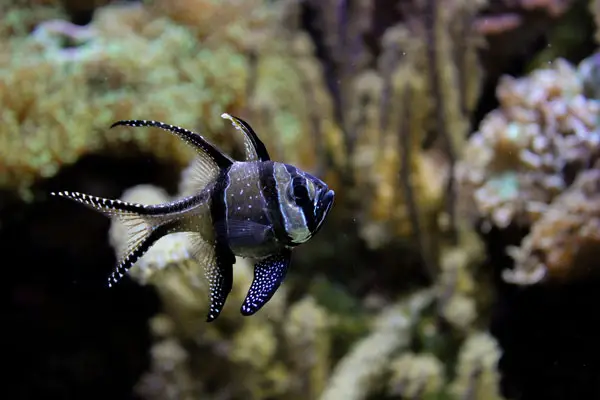
Background on the Banggai Cardinalfish
Banggai cardinalfish (Pterapogon kauderni) belong to the order Perciformes and the family Apogonidae. Their common name, “Banggai cardinalfish,” comes from their native territory,
the waters surrounding the Banggai islands in the Indonesian archipelago.

Banggai cardinalfish are hardy, peaceful, and suitable for most saltwater tanks with other appropriately sized, peaceful species. If you’re looking for a species with cool features, these fish are mouthbrooders. The males incubate the eggs in their mouth and release well-developed, miniature fry around the 20th-day post-spawn. This behavior is unique to the Banggai cardinalfish. Other cardinalfish only brood the eggs for a few days, releasing pelagic fry as soon as they hatch. Of course, Banggais also have the smallest clutch sizes out there, so there’s room in the male’s mouth to accommodate this behavior.
Choosing a Mating Pair of Banggai Cardinalfish
If you’re setting out to breed your Banggais, you need to start with a mated pair (at least, that first step usually helps). Unfortunately, determining the gender of a juvenile Banggai cardinalfish can be a difficult task. Both sexes look remarkably similar, especially when they’re young. If you’re willing to take some time in the fish store (or with your friend who’s already started breeding these fish), though, there are a few things to look for to improve your odds.
The first thing to look for is a slight “bulldog” appearance along the jaw-line, which is evident in males. As I just mentioned, males incubate the eggs and fry in their mouth, creating a sexually dimorphic jaw appearance. (Ironic since male and female bulldogs have the same appearance and don’t reproduce by mouthbrooding – they require a cesarean section – but I digress)
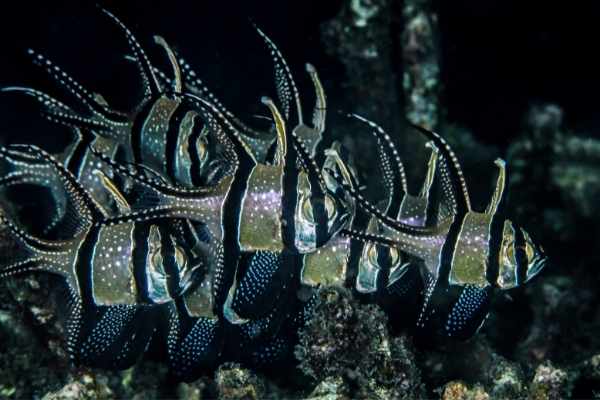
A second thing to look for is an elongated second dorsal fin, sometimes called the banner fin. You’ll see the literature note this as a sexually dimorphic trait, but it can get difficult to discern, and it’s often unreliable, especially for juveniles. However, it doesn’t hurt to keep an eye for the difference.
The most important trait, in my opinion, is the behavior of the fish in the holding tank. A pair may be in the early stages of bonding, so look for two fish hanging out together. Plus, since male cardinals are often intolerant of other males, you can sometimes note the squabbles and reduce your odds of bringing home two males.
I liken this part of the breeding process to counting cards in Black Jack. You’re gambling, but your odds of success are improving. Of course, the tried-and-true way to ensure you’ll end up purchasing a mated pair of Banggai cardinalfish is to acquire 4-5 fish and let them pair off naturally. But that takes time, and what fun is that?
Acclimating Your Banggai Cardinalfish
Once you’ve brought your Banggai cardinalfish home from the store, you’re going to have to acclimate them to life in your quarantine tank. Acclimating the Banggai cardinalfish is a relatively simple task. My pair spent about a month in a 20-gallon (76L) quarantine tank. They refused flake food and frozen brine shrimp (Artemia) initially. The only live food I had available at the time was live brine shrimp from my local fish store. THAT they were interested in accepting.
By the end of two weeks, I was able to wean them onto my store of frozen brine shrimp, which I then mixed with frozen mysid shrimp.
After that month in quarantine, I added them to my 75-gallon (284L) community tank. They continued their aggressive appetites. The pair hung out, ate, and grew fat in the community for about 4-5 months before a scheduled vacation of mine came around. (I know you didn’t come to hear to read about my vacation. I promise it’s important, though)
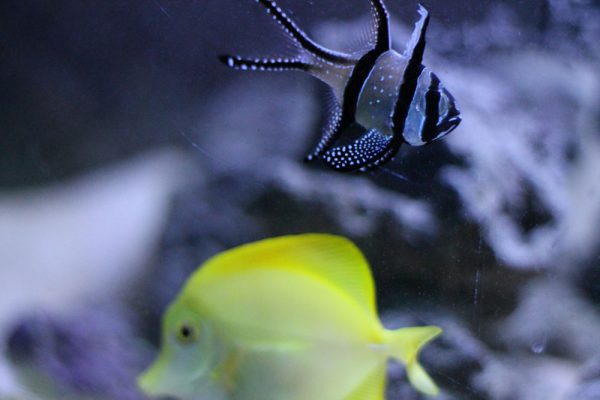
The “Vacation Trick”
Two weeks before my vacation, I performed water changes aggressively. I wanted to get the water quality pristine before I left. I also intentionally over-fed the fish in the days before I left to help them store up energy reserves for the week-long fasting they were about to experience.
Over time, I’ve found this strategy (excessive cleaning and feeding in advance of a trip) to be more reliable than hiring a “fish sitter” (which invariably ends in a minor – but expensive – catastrophe). Captive fish, in my estimation, tend to get over-fed (or is it under-exercised?) compared to their wild counterparts and do perfectly fine with a week-long fast.
I suspect my vacation protocol contributed to two potential spawning triggers:
- The Banggai cardinalfish gorging on Artemia (frozen “live” food
- Changing water parameters from the increased cleaning activity
These stimuli are commonly used to intentionally trigger spawning behavior in many captive fish. And while it may be a by-product of my pre-vacation protocol, it’s noteworthy to consider them potentially replicable stimuli for triggering breeding behavior in Banggai cardinalfish.
I left for vacation on a Saturday afternoon and returned one week later. All of the aquarium inhabitants were eager for their first meal except for ONE fish. The male Banggai cardinalfish had an exaggerated bulldog look. And looked like he had eggs, marbles, or even bulldogs in his mouth. Common to many mouth-brooding species, the male’s appetite gets suppressed while he is incubating eggs. And that’s exactly why he didn’t come looking for his meal.
Brine Shrimp Hatchery
Okay, I’m sandwiching a few steps into one (you caught me), but they make sense when you think about them. Your focus here is sequestering the male and preparing the way for the impending Banggai cardinalfish fry. After all, you went through a lot of work going on vacation, and you don’t want to risk missing out on your reward of baby cardinalfish!
Catching the male Banggai Cardinalfish was tricky. I found the best strategy was to use my hands to corral him into a breeders’ net and remove him that way. Chasing him around with the net proved unfruitful. He’s a dutiful parent, and he wanted to protect those eggs at all costs. Since I didn’t want to stress him out, I stalked him for a few days before I managed to get him. (Note: a stressed Banggai cardinalfish with eggs WILL swallow them)
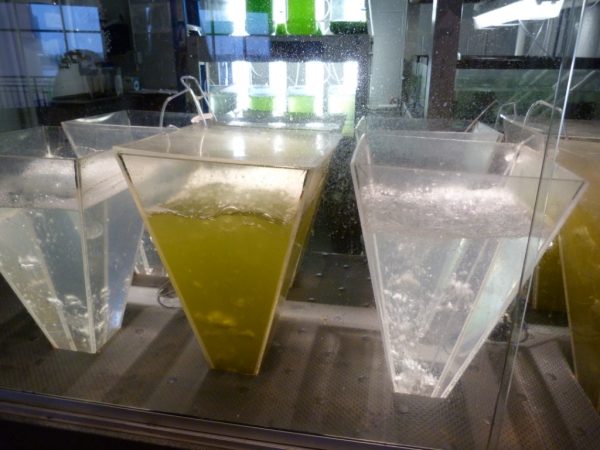
Next, you need to make sure you’ll have food prepared for those Banggai fry. You have some time before the male sets them loose, but you want to get started and get your shrimp growing. I used an old sports drink bottle, an air pump, and airline tubing to set up my brine shrimp hatchery. It wasn’t fancy, but it worked. I filled the plastic bottle (2L in size) with half-strength aquarium water, dropped in a few rehydrated brine shrimp cysts, inserted the airline tube, and that was that.
While fully formed, Banggai cardinalfish fry are TINY. They’ll end up on the menu if you allow them to stay in your community tank. So you’ll also need a separate space for them to get some additional size under their fins. It doesn’t need to be fancy or sophisticated. The grow-out tank I used was a simple 10-gallon (38L) rectangular tank with a sponge filter and a piece of live rock.
Common Mistakes When Breeding Banggai Cardinalfish
Obviously, you experience some trial and error when you’re starting something new for the first time. YOU get to have the benefit of learning from my mistakes, though. This is why I’m going to be honest with you.
Because I was on vacation, I wasn’t sure when my pair of Banggai cardinalfish first spawned. I looked up sources online and found out the fry generally emerge from the male’s mouth around day 20. Well, I decided I had time, and I actually stopped hatching brine shrimp. I figured I’d just wait until day 20 to turn everything back on.
The problem with that logic? My Banggai fry came earlier than I expected! So the lesson I can pass on is: be ready for the fry a few days in advance. You don’t want to run out of food for them.
But even with that major miscalculation, I still managed to succeed. I used the grow-out tank as a water bath to warm the temperature of the brine shrimp bottle and speed the hatch rate. The Banggai cardinalfish fry DID go for about a day-and-a-half without food. (Yikes!) But they hung in there. Leaning on the side of caution, I added a second hatchery bottle to the mix so I could use up a batch one day and hatch a new batch the second. It worked (but try to avoid this complication).
Raising Banggai Cardinalfish Fry
The remaining fry emerged one by one over the next few days. During this time, I could see the tiny Banggai cardinalfish through the male’s translucent skin. They were clearest before the lights went out. And despite my care and planning, only FIVE juvenile fish emerged. (It was a start, at least)

Determining when to remove the male was simple; his behavior and appearance shifted dramatically. The first and most notable change was his jaw-line: it returned to the pre-spawn shape. And second, he became more active and started gulping stray nauplii. Luckily, he avoided offspring (at least, that I noticed).
I fed the Banggai cardinalfish fry twice a day with 1 to 2-day old brine shrimp nauplii. I used a turkey baster to suck up the wiggling brine shrimp and dropped the liquid into the tank.
In hindsight, I recommend you get a brine shrimp net or another way to separate the nauplii from their disgusting hatchery water. You can use a flashlight to concentrate the brine shrimp into one area of the hatchery before you suck them up with the turkey baster.

For More Information
There is a great book dedicated to the Banggai cardinalfish. It’s a great read, with some gorgeous pictures and an amazing cause/charter: Banggai Cardinalfish: A Guide to Captive Care, Breeding & Natural History, by Ret Talbot, Matt Pedersen, Matthew L. Wittenrich, Ph.D.
And if you seriously want to try to breed these fish, there are two MUST READ resources for you to check out:
- Hopkins et al. “Manual for the Production of the Banggai Cardinalfish Pterapogon kauderni, in Hawai’i.” University of Hawaii: College of Tropical Agriculture and Human Resources. December 2005. www.raingarden.us/banggaimanual.pdf
- The breeding forums over at MOFIB. It’s an awesome resource and community of people out there who want to breed these fish.
Want to see these stunning fish in action? Watch this YouTube video to learn everything you can about the Banggai cardinalfish:
The Banggai cardinalfish is an amazing choice for any saltwater aquarium, but there are other great community fish you can consider, too:
- Pajama cardinalfish (you know, in case you want another mouthbrooder)
- Royal gramma
If you are interested in learning more about breeding popular saltwater fish, consider these helpful guides:
Conclusion
A standard brood size for Banggai cardinalfish is between 30-50. Under-sized broods or aborted broods are common for the first few breeding cycles of many fish, and there’s no exception with these dramatic little guys. Since I missed the actual spawning event, I can’t verify how many eggs ended up fertilized. But in all, five juvenile fish were released. While the spawn may have been undersized, the vigor of the surviving fish was encouraging.
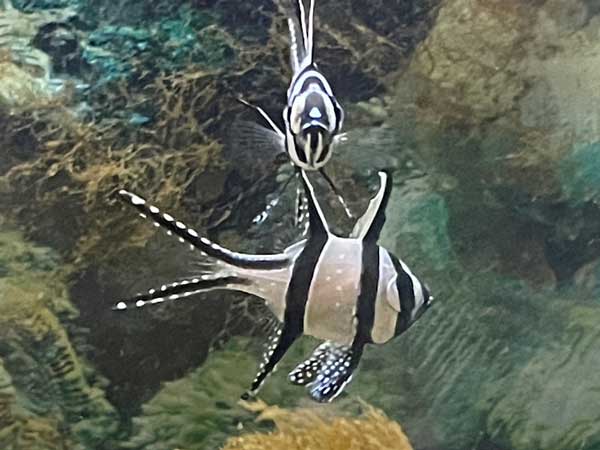
These wonderful fish were bred in a community tank while I was on vacation. I DID stress the male by chasing him with a net for a couple of days before I caught him. And I suspended him in the breeder’s net for a few more days before I moved him to an entirely new tank to release the young. I exhibited a lack of patience and a lack of planning that resulted in a 36-hour fast upon release for the very first fry. Despite the stress, the fish thrived.
If you want to breed Banggai cardinalfish, learn from the mistakes I made. At the same time, be confident that you WON’T need a perfect technique to make it a reality. Buy a pair of captive-raised Banggai cardinalfish from your local fish store. Feed them well, and four to five months after you do? Take a vacation. (Yes, I give you permission to do so)
That’s what I did. Let the fish take care of the rest. Oh, yeah, and buy Artemia cysts in bulk.
References
- Marini, Frank C. “My notes and observations on Raising and Breeding the Banggai Cardinalfish.” The Journal of Marine AquaCulture. Volume 4, Issue 4. 1996
- Hopkins et al. “Manual for the Production of the Banggai Cardinalfish Pterapogon kauderni, in Hawai’i.” University of Hawaii: College of Tropical Agriculture and Human Resources. December 2005. www.raingarden.us/banggaimanual.pdf
Written by Albert B. Ulrich III.

Leave a Reply